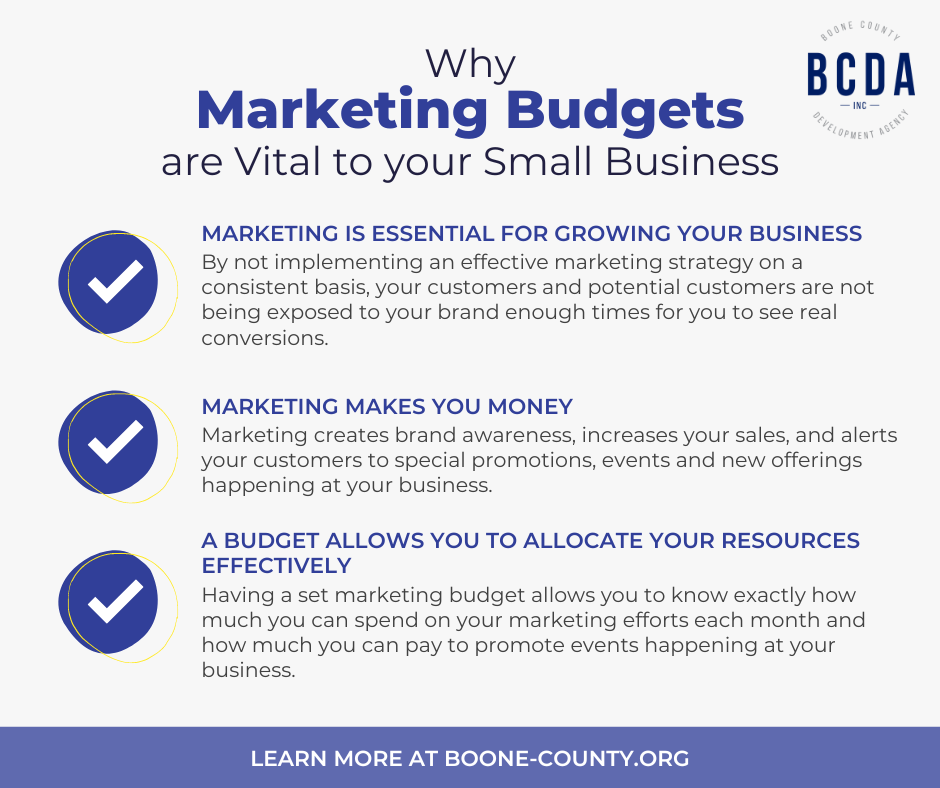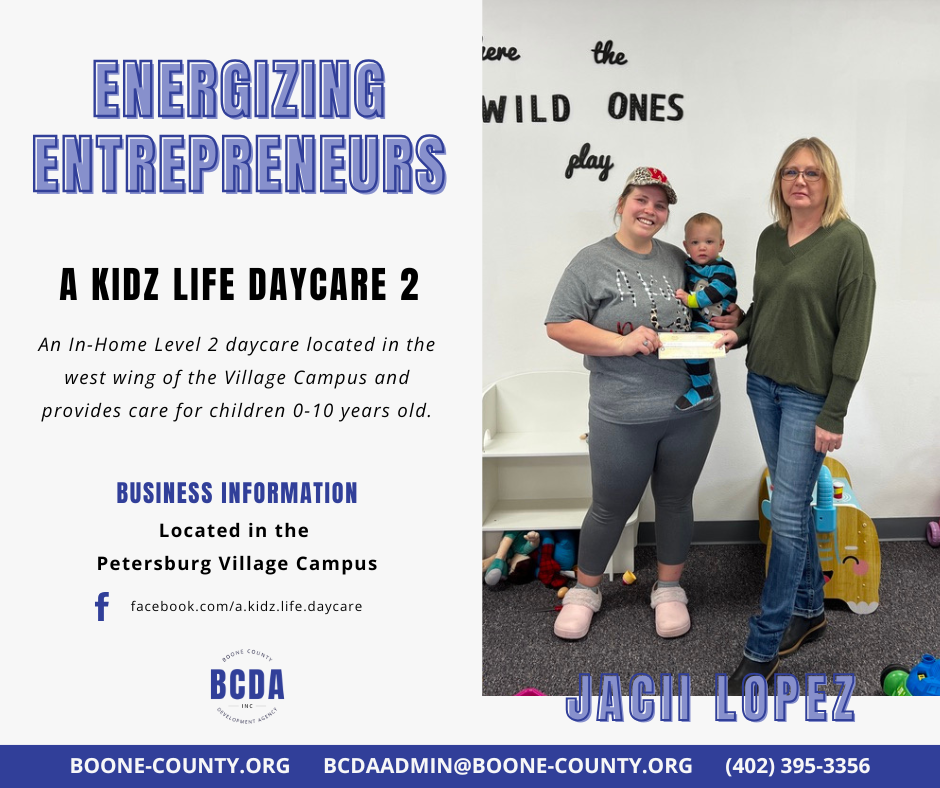During many conversations with local Boone County businesses, we are often asked for help with marketing guidance. In order to get a better understanding of each business, we ask what their marketing budget is.
Some common responses we receive are:
- My business utilizes free social media posts as our way to market our brand.
- I operate a small business and feel that I don’t have the funds to allocate to marketing.
- I don’t even know where to start with marketing or a marketing budget.
All of these are completely understandable responses, but this is potentially what is holding your small business back from growing and reaching your target audience.
Why are marketing budgets so important to small businesses? Let’s get into it.
Marketing Is Essential For Growing Your Business
First of all, marketing is how potential customers know that your business even exists. In order to grow your business and make more money, you need to market your brand in a way that attracts new, potential customers and entices existing customers to keep returning.
Marketing is one of the first steps toward establishing a connection with an audience. It’s a critical need for building lasting relationships with those most likely to spend their money with you.
Your customers want to know what you do and how you do it. They also want to feel a connection with your brand. They need to be subtly convinced that they need your products or services in their lives and why they should keep coming back, all while telling their friends and family, too.
But it’s not enough to just post something one time and then wait for customers to come running. In marketing, there is a Rule of 7. This thought process states that it takes your potential customer an average of seven interactions with your brand before they take an action, like going to your store or visiting your website.
So if you are not implementing an effective marketing strategy on a consistent basis, then your customers and potential customers are not being exposed to your brand enough times for you to see real conversions.
Marketing Makes You Money
If marketing is how your customers find your business, then it’s also how your business makes money. Marketing creates brand awareness, increases your sales, and alerts your customers to special promotions, events and new offerings happening at your business.
But for most small businesses, organic marketing isn’t enough to reach your potential customers. You know what they say, “it takes money to make money.”
Having a paid marketing strategy will help put your brand in front of more of your target audience because the reach is far greater than organic marketing.
The general rule of thumb for creating a marketing budget is that you should allocate 10% of your annual income to marketing. This is not set in stone. You need to pick a number that your business is comfortable with. Essentially, you do not have to spend a fortune to get results, especially when marketing online.
A Budget Allows You To Allocate Your Resources Effectively
Having a set marketing budget allows you to know exactly how much you can spend on your marketing efforts each month and how much you can pay to promote events happening at your business.
Your budget helps you determine which platforms you can market on as well. This includes paid social media, Google ads, email marketing, local newspapers, events, etc.
Paid marketing also allows you to analyze the results of your efforts. When marketing online, there are built-in analytics on each platform you utilize that you can refer back to. This allows you to see exactly how much reach your campaign had and if your return on investment was worth the effort.
Budgeting Your Time vs. Your Money
Regardless of whether you are spending money or not to market your business, you are still paying. Your time is just as, if not more, valuable as the money you make. If your strategy is to utilize free social media posts, what is that costing you in time?
Let’s Break Down the Cost of Your Time
Social media can be extremely sensitive when it comes to showing your customers what you post. Just because you put it on your page does not mean that it is being seen by your audience.
In order to keep the powers that be happy on whatever social media platform you use, there are a few things that you need to be doing.
Consistency:
In order to be effective on any social media platform, you need to be consistent. That means you need to post the same amount of times every week. Whether it’s once a week or once a day, the social media platform that you’re using will register your pattern and reward you for being consistent, or punish you for being sporadic.
You need to determine how often you will post, on what days, and at what times your posts will receive the most interaction from your target audience.
Creating:
Consistency is extremely important, but the content you create is just as important. Gone are the days when you could just throw something up and your customers would respond.
Quality content is the key to performing well on social media. When it comes to creating photos, videos, graphics, etc., careful thought and planning needs to be taken into consideration.
Your business industry will determine what type of content you create. If you sell products or are in the food service industry, then photos and videos are a must. If you sell a service, then you can lean more on graphics with some photos and videos sprinkled in.
You need to determine if this is something that you are capable of doing in the time you have budgeted for marketing, or if this is something you need to consider outsourcing.
Copy:
Now that you have the content created, what are you going to say about it? This is your opportunity to talk about your products or services, or educate your audience about what you offer. Your social media copy helps round out the point you are trying to sell.
Keep in mind that social media is constantly changing and things like hashtags, keywords and SEO play into every caption in order for your post to be found organically by new customers.
Posting/Scheduling:
Once you have your posting consistency determined, you’ve created the content you want to share and you have the copy written, it’s time to post on social media.
Thankfully, there is scheduling software available that will help free up some of your time. Some of the software is free, like the Meta Business Suite for Facebook and Instagram, and some you would have to pay for.
Interacting:
Social media is not a set-it-and-forget-it platform. You need to interact with your audience. Essentially, you need to be social on social media. These platforms reward you for interaction. What does that mean? Your content will be shown to more people if you are actively engaging with your audience.
At the bare minimum, you should be interacting on each social platform for at least 30 minutes after posting your content.
Total cost of your time:
Let’s say you are posting three times a week on Instagram and Facebook. It takes you 30 minutes to create each piece of content, plus another 15 minutes to write the copy for each. You schedule your posts so that only takes 15 minutes per week. But now you have to interact with your community for at least 30 minutes on each platform after you have posted.
Your total marketing time for two social media platforms is: 5.5 hours per week on just three days’ worth of social media content. As a business owner, let’s say your hourly rate is $50. Five and a half hours of “free” social media marketing is costing your business $1,110/month.
This doesn’t include the time spent marketing on other online platforms or local newspaper and radio ads.
Overview
Marketing can sometimes feel overwhelming, but it doesn’t have to be. Establish a marketing plan and determine what your budget will look like based on your goals. BCDA is always here to help your business. Reach out to our office to set up a meeting if you would like to discuss anything from this article further.







